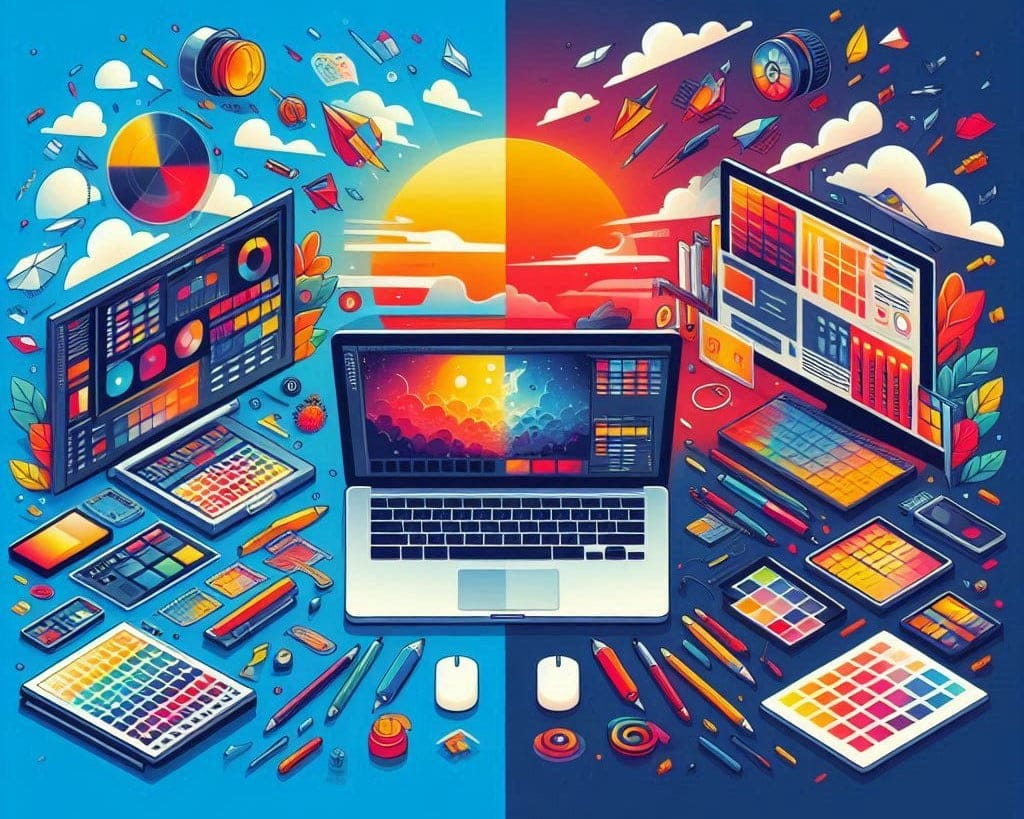Are you torn between a laptop and a desktop for your graphic design projects? Choosing the right machine can significantly impact your workflow and productivity. In this guide, we’ll delve into the key factors to consider when making this decision, helping you find the perfect fit for your needs.
From portability and performance to budget and display quality, we’ll explore the pros and cons of each option. Whether you’re a professional designer or a hobbyist, this article will provide valuable insights to guide your purchase.
So, let’s dive in and discover which machine is the best fit for your graphic design endeavors.
Advantages of Laptops for Graphic Design
- Portability: Unlike desktops, laptops offer the ultimate freedom to work from anywhere. Coffee shops, client meetings, or even a relaxing vacation spot – your design studio can travel with you.
- All-in-one solution: Laptops come with a built-in monitor, keyboard, and trackpad, eliminating the need for separate peripherals. This streamlined setup makes them ideal for mobile designers who value efficiency.
- Wide range of choices: The laptop market caters to a wide range of budgets. You can find affordable options for basic design work or splurge on high-performance machines for demanding projects.
Disadvantages of Laptops for Graphic Design
- Processing power: Laptops, while improving, often pack less processing power compared to desktops. This can be a bottleneck for tasks like 3D rendering or video editing that require significant processing muscle.
- Screen size: Most laptops come with screens that are on the smaller side, limiting the real estate you have for your design projects. Scrolling and zooming become more frequent, potentially hindering your creative flow.
- Upgradability limitations: Unlike desktops, upgrading key components like graphics cards in laptops is often difficult or even impossible. This can limit the lifespan of your machine as software and design demands increase.
Advantages of Desktops for Graphic Design
- Processing power: Desktops reign supreme when it comes to raw processing power. They can house powerful CPUs and high-end graphics cards, making them ideal for tackling demanding design tasks like 3D animation, complex photo manipulation, and high-resolution video editing.
- Screen options: Desktops offer a wider range of monitor options, allowing you to create a spacious and customized workspace. Dual or even triple monitor setups become a possibility, giving you a clear overview of your projects and enhancing your multitasking abilities.
- Upgradeability: Desktops are champions of upgradability. With easy access to internal components, you can swap out outdated parts like RAM, storage drives, and even graphics cards to keep your system running smoothly as your design needs evolve. This extends the lifespan of your machine and saves you money in the long run compared to needing to buy a whole new computer.
Disadvantages of Desktops for Graphic Design
- Lack of portability: Unlike laptops, desktops are confined to a single location. This lack of portability can be a dealbreaker for designers who need to collaborate on-site with clients or take their work on the go.
- Larger space: Desktops, with their towers and multiple monitors, require dedicated desk space. This can be a challenge for those with limited living or working areas.
- Expensive: High-performance desktops with powerful graphics cards and large monitors can come with a hefty price tag upfront compared to laptops with similar specs. However, the upgradability advantage can offset this cost in the long run.
Making the Choice: Consider Your Needs
Choosing between a laptop and a desktop for graphic design boils down to understanding your specific workflow and priorities. Here are some key factors to consider:
1. Portability vs. Performance:
- Do you need the flexibility to work from anywhere? If mobility is crucial, a laptop is the clear winner.
- Do you primarily work on complex projects requiring heavy processing power? If raw power is your priority, a desktop is the better option.
2. Type of Graphic Design:
- Do you focus on 2D design work like logos, illustrations, or web graphics? A good laptop with a decent graphics card might suffice.
- Do you delve into 3D modeling, animation, or high-resolution video editing? A desktop with a powerful CPU and dedicated graphics card is highly recommended.
3. Budget:
- How much are you willing to spend upfront? Laptops tend to be more affordable initially, but upgrades are limited.
- Are you comfortable with a potentially higher initial cost for a desktop, knowing you can upgrade components later? This can be a more cost-effective strategy in the long run.
For more information read: How to Choose Laptop for Graphic Design
Conclusion
The battle between laptops and desktops for graphic design is a close one, with each offering distinct advantages. By carefully evaluating your workflow, considering factors like portability, performance needs, budget, and even operating system preference, you can make an informed decision.
Remember, the ideal computer should empower your creativity, not hinder it. Choose wisely, and get ready to unleash your design potential!

